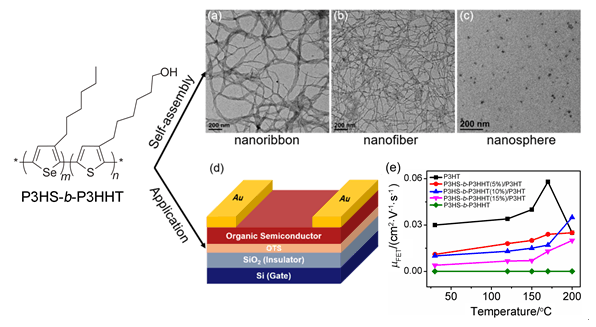| [1] Horowitz, G. Adv. Mater. 1998, 10, 365.
[2] Kim, N. K.; Jang, S. Y. G.; Caironi, P. M.; Park, W. T.; Khim, D.; Kim, J.; Kim, D. Y.; Noh, Y. Y. Chem. Mater. 2015, 27, 8345.
[3] Yang, N.; Qiao, X.; Fang, R.; Tao, J.; Hao, J.; Li, H. Acta Chim. Sinica 2016, 74, 335. (杨宁, 乔小兰, 房忍忍, 陶竞炜, 郝建, 李洪祥, 化学学报, 2016, 74, 335.)
[4] Lu, Y.; Ding, Y.; Wang, J. Chin. J. Org. Chem. 2016, 36, 2272. (卢阳, 丁一凡, 王婕妤, 裴坚, 有机化学, 2016, 36, 2272.)
[5] Günes, S.; Neugebauer, H.; Sariciftci, N. S. Chem. Rev. 2007, 107, 1324.
[6] Zhao, C.; Wang, Z.; Zhou, K.; Ge, H.; Zhang, Q.; Jin, L.; Wang, W.; Yin, S. Acta Chim. Sinica 2016, 74, 251. (赵蔡斌, 王占领, 周科, 葛红光, 张强, 靳玲侠, 王文亮, 尹世伟, 化学学报, 2016, 74, 251.)
[7] Nian, Y.; Wang, Z.; Jiang, H.; Feng, S.; Li, S.; Zhang, L.; Cao, Y.; Chen, Y. Chin. J. Chem. 2018, 36, 495.
[8] Perepichka, I. F.; Perepichka, D. F.; Meng, H.; Wudl, F. Adv. Mater. 2005, 17, 2281.
[9] Boudouris, B. W.; Frisbie, C. D.; Hillmyer, M. A. Macromolecules 2008, 41, 67.
[10] Wang, H.; Tang, G.; Jin, S.; Bian, C.; Han, F.; Liang, D.; Xue, X.; Acta Chim. Sinica 2007, 65, 2454. (王红敏, 唐国强, 晋圣松, 边成香, 韩菲菲, 梁丹, 徐学诚, 化学学报, 2007, 65, 2454.)
[11] Brinkmann, M.; Wittmann, J. C. Adv. Mater. 2006, 18, 860.
[12] Scherf, U.; Gutacker, A.; Koenen, N. Acc. Chem. Res. 2008, 41, 1086.
[13] Kim, J.; Song, I. Y.; Park, T. Chem. Commun. 2011, 47, 4697.
[14] Park, J. Y.; Koenen, N.; Forster, M.; Ponnapati, R.; Scherf, U.; Advincular, R. Macromolecules. 2008, 41, 6169.
[15] Thomas, A.; Houston, J. E.; Van der Brande N.; Winter, J. D.; Chevrer, M.; Heenan, R. K.; Terry, A. E.; Richeter, S.; Mehdi, A.; Mele, B. V.; Dubois, P.; Lazzaroni, R.; Gerbaux, P.; Evans, R. C.; Clement, S. Polym. Chem. 2014, 5, 3352.
[16] Li, Z.; Huo, Y.; Yang, X.; Ji, S. Chin. J. Org. Chem. 2016, 36, 2317. (李宗植, 霍延平, 阳香华, 籍少敏, 有机化学, 2016, 36, 2317.)
[17] Liu, Y.; Yuan, J.; Zou, Y.; Li, Y. Acta Chim. Sinica 2017, 75, 257. (刘晔, 袁俊, 邹应萍, 李永舫, 化学学报, 2017, 75, 257.)
[18] Shao, R.; Yang, X.; Yin, S.; Wang, W. Acta Chim. Sinica 2016, 74, 676. (邵绒, 杨鑫博, 尹世伟, 王文亮, 化学学报, 2016, 74, 676.)
[19] Li, H.; Fang, M.; Xu, T.; Hou, Y.; Tagn, R.; Chen, J.; Liu, L.; Han, H.; Peng, T.; Li, Q.; Li, Z. Org. Chem. Front. 2016, 2, 233.
[20] Gutacker, A.; Adamczyk, S.; Helfer, A.; Garner, L. E.; Evans, R. C.; Fonseca, S. M.; Knaapila, M.; Bazan, G. C.; Burrows, H. D.; Scherf. U. J. Mater. Chem. 2010, 20, 1423.
[21] Lai, Y. C.; Ohshimizu, K.; Takahashi, A.; Hsu, J. C.; Higashihara, T.; Ueda, M.; Chen, W. C. J. Polym. Sci., Part A:Polym. Chem. 2011, 49, 2577.
[22] Yu, X.; Xiao, K.; Chen, J.; Lavrik, N. V.; Hong, K.; Sumpter, B. G.; Geohegan, D. B. ACS Nano 2011, 5, 3559.
[23] Gilroy, J. B.; Lunn, D. J.; Patra, S. K.; Whittell, G. R.; Winnik, M. A.; Manners, I. Macromolecules 2012, 45, 5806.
[24] Moon, H. C.; Anthonysamy, A.; Kim, J. K. Macromolecules 2011, 44, 1894.
[25] Verduzco, R.; Botiz, I.; Pickel, D. L.; Kilbey, M. S. Hong, K.; Dimasi, E.; Darling, S. B. Macromolecules 2011, 44, 530.
[26] Ge, J.; He, M.; Xie, N.; Ye, Z.; Qiu, F. Macromolecules 2015, 48, 279.
[27] Wu, P. T.; Ren, G.; Li, C.; Mezzenga, R.; Jenekhe, S. A. Macromolecules 2009, 42, 2317.
[28] Yang, H.; Zhang, R.; Wang, L.; Zhang, J.; Yu, X.; Geng, Y.; Han, Y. Polymer 2016, 97, 238.
[29] Song, I. Y.; Kim, J.; Im, M. J.; Moon, B. J.; Park, T. Macromolecules 2012, 45, 5058.
[30] Scherf, U.; Adamczyk, S.; Gutacker, A.; Koenen, N. Macromol. Rapid Commun. 2009, 30, 1059.
[31] Ho, V.; Boudouris, B. W.; Segalman, R. A. Macromolecules 2010, 43, 7895.
[32] He, M.; Han, W.; Ge, J.; Yang, X.; Qiu, F.; Lin, Z. Energy Environ. Sci. 2011, 4, 2894.
[33] Yang, X.; Ge, J.; He, M.; Ye, Z.; Peng, J.; Qiu, F. Macromolecules 2016, 49, 287.
[34] Zhu, M.; Kim, H.; Jang, Y. J.; Park, S.; Ryu, D. Y.; Kim, K.; Tang, P.; Qiu, F.; Kim, D. H.; Peng, J. J. Mater. Chem. A 2016, 4, 18432.
[35] Xia, H.; Ye, Z.; Liu, X.; Peng, J.; Qiu, F. RSC Adv. 2014, 4, 19646.
[36] Wang, Y.; Cui, H.; Zhu, M.; Peng, J.; Lin, Z. Macromolecules 2017, 50, 9674.
[37] Hollinger, J.; Jahnke, A. A.; Coombs, N.; Seferos, D. S. J. Am. Chem. Soc. 2010, 132, 8546.
[38] Patra, A.; Bendikov, M. J. Mater. Chem. 2010, 20, 422.
[39] Ge, J.; He, M.; Yang, X.; Qiu, F. Macromolecules 2010, 43, 6422.
[40] Yang, H.; Xia, H.; Wang, G.; Peng, J. J. Polym. Sci., Part A:Polym. Chem. 2012, 50, 5060.
[41] He, L.; Pan, S.; Peng, J. J. Polym. Sci., Part B:Polym. Phys. 2016, 54, 544.
[42] Li, L.; Hollinger, J.; Jahnke, A.; Petrov, S.; Seferos, S. Chem. Sci. 2011, 2, 2306.
[43] Liu, J.; Arif, M.; Zou, J.; Khondaker, S.; Zhai, L. Macromolecules 2009, 42, 9390. |
